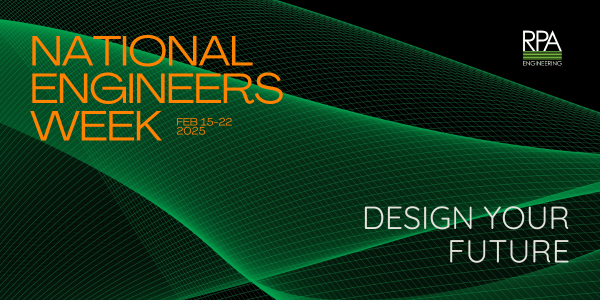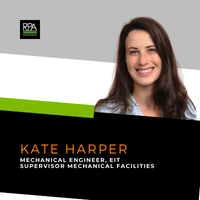
As we celebrate National Engineers Week, we’re launching a three-part interview series featuring various engineers here at RPA Engineering who are helping to shape the future of engineering. This year’s theme is “Design Your Future” and we asked our team to discuss how engineers tackle global challenges and build a better tomorrow.
National Engineers Week is a time to celebrate the innovation, dedication, and problem-solving prowess of engineers who shape our world. As we look to the future, engineers are at the forefront of addressing some of the most pressing global challenges, from sustainability and energy consumption to resilience in times of crisis.
In this first set of interviews, our engineers share their insights on the pivotal moments that shaped their careers, their vision for “building a better tomorrow,” and the role of collaboration in tackling complex global issues. Their experiences highlight the profound impact engineering has on society and the responsibility engineers carry in designing solutions that not only meet today’s needs but also create a sustainable and efficient future for generations to come.
Can you share a pivotal moment in your career when you realized the impact engineering could have on global challenges?
Jonathan Belinksi:
The pivotal moment for me came during the height of the COVID pandemic. I realized then, more than ever, that the engineering that goes on in the background of global companies is vital to keeping them up and running, especially in a time of crisis. During the pandemic, essential companies needed to pivot so they could continue producing invaluable goods with constraints on raw materials and shipping. The only way to be successful during that shift was to have a strong engineering team to support them and help them prepare for the future. Here at RPA, we had the privilege to work with leading global manufacturers to ensure that they were ready to produce products in a time of need.
Paul Parise:
In my Senior year at West Virginia University, I participated in a design competition called “Future Truck” which was also my capstone project. The project was aimed at addressing an increase in popularity in SUV’s which had a high rate of fuel consumption. It required designing, financing, and building a hybrid electric vehicle using a Ford Explorer but without using the stock powertrain. At the end of the competition, we competed with 14 other universities at Ford Proving Grounds.
This project set the tone for my consideration of design as it relates to environmental conditions. Upon graduating in 2003 and entering my first position an engineering consultant, the firm had a LEED project for the Department of Energy. These back-to-back experiences ultimately led to the decision to become a LEED accredited design professional.
By balancing resilience, sustainability, and practicality, we can create meaningful progress for future generations.
Alex Lee
What does "building a better tomorrow" mean to you as an engineer?
Alex Lee:
Creating solutions that address today’s challenges while preparing for the future. As an engineer, this involves designing resilient systems that can withstand unexpected stresses and adapt to change. Sustainability is key: requiring efficient resource use, renewable materials, and waste reduction. Beyond technical aspects, we must consider the long-term social and environmental impact of our work. By balancing resilience, sustainability, and practicality, we can create meaningful progress for future generations.
Maclean Smith:
Engineers must consider the ways that they can enhance what already exists to make it more sustainable, efficient, and productive. When completing a project, engineers must not only consider the short-term challenges, but also work to provide long-term solutions that minimize issues for future generations.
David Horton:
A safer, brighter, and sustainable future. An engineer’s job is to bring the cutting edge of physics, chemistry, biology, and mathematics into a physical world to help solve global problems. Whether it is improving existing processes with our clients or helping them turn ideas into prototypes or bring them into production, we are improving our world for a better tomorrow every day.
Samantha Owens:
Identifying solutions that solve today’s problems, but also that minimize or eliminate problems in the future. Creating thoughtful, calculated designs with materials that will last, or be easily replaced and maintained, with minimal safety risk to people.
Matt Russell:
Building a better tomorrow to me means leaving things better than I found them. Whether that be on a project or even using a conference space, the micro actions of leaving things better than you found them on a consistent basis can lead to macro changes.
Paul Parise:
Effective and durable design. If a design is effective, it is because it functions well and is designed with the future in mind. If it is durable, it performs the task intended reliably and as a result, there no need to replace for a long time. This reduces the level of effort and use of resources over the long term.
Creating innovative solutions to tough problems rarely emerge in a vacuum.
Paul Parise
What are some of the most pressing global challenges engineers must address today?
Paul Parise:
An increasing demand to consume energy creates issues in terms of the quantity and what types of energy we use with the consequences in terms of emissions or storage of spent fuel.
David Horton:
The globe is facing old challenges of providing energy, food, and shelter to all people, while new technologies provide a Catch 22 to reaching long term solutions. AI and renewable energies require immense amounts of power and rare minerals putting them at odds with our sustainability goals. Yet these solutions are worth pursuing for their long-term benefits of improving standards of living and environmental concerns. Each technological revolution has brought vast improvements to people’s lives but with drawbacks. Forging ahead to solve these problems will require specialty expertise to solve our energy and environmental problems.
What role does collaboration across disciplines play in solving complex global problems?
Paul Parise:
Creating innovative solutions to tough problems rarely emerge in a vacuum. It requires the collective talents of many to take an idea to reality. Problem solving operates on a common rule: what happens on one side of an equation affects the other side. To operate in balance, any solution to a problem requires an understanding of what disadvantages may occur, which requires investigation of all the aspects of the solution – including economic, technical, and social.











